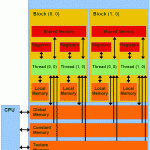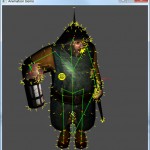In this article I will discuss how you can use OpenGL textures and buffers in a CUDA kernel. I will demonstrate a simple post-process effect that can be applied to off-screen textures and then rendered to the screen using a full-screen quad. I will assume the reader has some basic knowledge of C/C++ programming, OpenGL, and CUDA. If you lack OpenGL knowledge, you can refer to my previous article titled Introduction to OpenGL or if you have never done anything with CUDA, you can follow my previous article titled Introduction to CUDA.
Tag Archives: Graphics
CUDA Memory Model
In this article, I will introduce the different types of memory your CUDA program has access to. I will talk about the pros and cons for using each type of memory and I will also introduce a method to maximize your performance by taking advantage of the different kinds of memory.
I will assume that the reader already knows how to setup a project in Microsoft Visual Studio that takes advantage of the CUDA programming API. If you don’t know how to setup a project in Visual Studio that uses CUDA, I recommend you follow my previous article titled [Introduction to CUDA]
Continue reading
GPU Skinning of MD5 Models in OpenGL and Cg
This tutorial builds upon the previous article titled [Loading and Animating MD5 Models with OpenGL]. It is highly recommended that you read the previous article before following this one. In this tutorial, I will extend the MD5 model rendering to provide support for GPU skinning. I will also provide an example shader that will perform the vertex skinning in the vertex shader and do per-fragment lighting on the model using a single point light. For a complete discussion on lighting in CgFX, you can refer to my previous article titled [Transformation and Lighting in Cg].
Continue reading
Loading and Animating MD5 Models with OpenGL
In this article, I will show how you can load and animate models loaded from the MD5 model file format. In this article I will use OpenGL to render the models. I will not show how to setup an OpenGL application in this article. If you need to get a quick introduction on setting up an OpenGVL application, you can follow the “Beginning OpenGL for Game Programmers” article [here].
Introduction to DirectX 9 for Game Programmers

DirectX
In this article I will give a quick introduction to DirectX. I will use Visual Studio 2008 as a development environment for this tutorial and I will start by showing how to install DirectX and configure Visual Studio 2008 to start developing DirectX applications. I assume that the reader has basic programming knowledge in C++. If you require a math refresher, you can refer to my “3D Math Primer” articles on Coordinate Spaces, Vector Operations, and Matrices.




